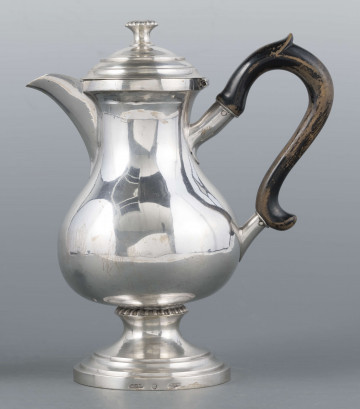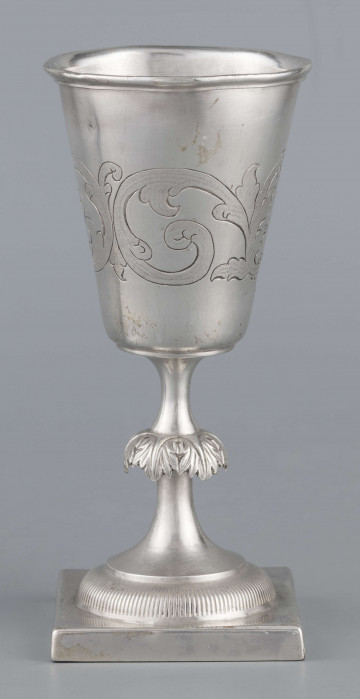
Platter
1832 — 1850
National Museum in Lublin
Part of the collection: Goldsmithery
Originating from the goldsmith's workshop of Karol Rotkiel, the sugar bowl is an extraordinary example of the Lublin goldsmith's workshop. The artist, although born in Warsaw, acquired his workshop skills from Italian masters. After returning to Poland he settled in Lublin, where on 13 February 1833 he was entered into the register of Lublin citizens. It was here, at 21 Krakowskie Przedmieście Street, that he opened one of the most valued 19th-century goldsmith's workshops in the country and gained fame and recognition as a master himself.
The lower part of the sugar bowl consists of a slightly bulged smooth surface ending in a turned-up collar at the half-height of the object, while the upper part – of a wide strip of die-cut tape. Die-cutting is a technique for shaping metal artistic products. In this method a goldsmith uses punches, i.e., stamps, as well as plates for pressing, called dies, and for one-off pressing of complex forms. With this method, a single strike of the punch or die is sufficient to emboss a complex design, which is a low relief of soft, continuous shape, devoid of sharp edges and angles.
In Rotkiel's sugar bowl we can see a frieze of stylised Gothic trilliums and below it an antique scene repeated three times. On the right we can see a cupid sitting on a boulder under a tree, playing the lyre. A female figure on the left also holds a lyre and plays to three dancing graces situated in the central part of the scene. The Roman Graces, known in Greece as Charites, were goddesses of grace, beauty and joy. They were fond of games, music and dance, and took particular care of beautiful young people. They were considered patrons of the fine arts and handicrafts. Their attributes were apples, perfume bottles, roses, myrtle, sometimes field plants: poppies or ears of grain. Graces were daughters of Zeus and the Okaeanida (sea nymph) Eurynome. They are most often depicted dancing as they hold hands. Aglaia (Radiant) was said to symbolise splendour, Thalea (Flowering) was said to symbolise flourishing life, and Euphrosyne (Reason) was said to symbolise social splendour. For Neoplatonism they were a symbol of the threefold aspect of love, and in the Middle Ages they were identified with beauty, charity and love. To this day, the dancing three graces are the epitome of grace and beauty.
Author / creator
Dimensions
cały obiekt: height: 15 cm, width: 12,5 cm
Object type
goldsmith's art
Technique
knurling
Material
silver
Creation time / dating
Creation / finding place
Owner
The National Museum in Lublin
Identification number
Location / status

1832 — 1850
National Museum in Lublin

1839 — 1850
National Museum in Lublin

1840 — 1851
National Museum in Lublin
DISCOVER this TOPIC
National Museum in Lublin
DISCOVER this PATH
Educational path